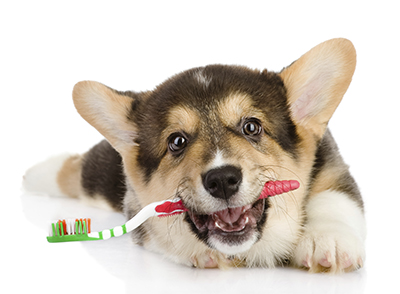
Have you taken a look in your cat’s or dog’s mouth recently? About 85 percent of dogs and cats older than 4 have some degree of periodontal disease.
A painful condition characterized by red, inflamed gums, odor and tartar on the tooth surface, periodontal disease can lead to abscesses and tooth loss. Left untreated, bacteria can enter the bloodstream and lead to infection of the heart, kidneys or liver. Ongoing dental infections even can lead to fracture of delicate jaw bones in small dogs.
I see dental disease in dogs and cats every day, and it amazes me how stoic most animals are. Sometimes, the problem is obvious. Your dog may be drooling excessively or have bad breath; your cat may not be eating as well, or may have a swelling in her mouth. But, very often, I’ll find a broken or infected tooth during a routine physical exam, and the owner is shocked because the pet hasn’t missed a beat.
Tooth problems in people are quite painful, and the same applies to our furry companions, even if they don’t make it obvious to us. An observant owner may note small, subtle changes: Maybe your dog doesn’t seem as enthusiastic about her dental chews lately, or she might be rubbing her face more. Perhaps your cat has begun to swallow his food whole. But sadly, often we don’t know just how much pain they were in until we see how happy and frisky they are after their diseased teeth have been addressed.

Dental health begins at home, and small changes — like brushing your pet’s teeth daily, if possible, or at least three times a week — can make a big difference. Of course, you know your pet’s temperament better than anyone, and it is important not to force the issue, but many pets will accept having their teeth brushed if you take a slow, patient approach and work to make it a pleasurable experience.
Begin by spending some time simply handling your pet’s head and mouth. Then offer a tasty, flavored pet toothpaste on your finger and begin rubbing her teeth and gums. Reapply the paste as needed, trying to move aside the lips to expose more of her teeth. (It can help to approach the mouth from the side or behind the pet; they seem to feel less threatened and are more cooperative.) Over time, increase the number of teeth you clean, finally moving to the ones in the very back. Once you feel comfortable with your fingers, you can try a soft-bristle toothbrush, finger brush or even a piece of gauze or cloth. Don’t be discouraged when things don’t go well at first; it can take time to gain your pet’s trust.
There are also a wide variety of dental treats, chews, sprays and gels available, which are designed to help reduce plaque and bacteria build-up in the mouth. You can use them to supplement your at-home dental care routine, or use these products exclusively for pets that do not tolerate brushing. Look for the “VOHC-approved” stamp on the pet oral care products, which means they meet the tooth-cleaning protocols established by the Veterinary Oral Health Council.

Unfortunately, periodontal disease in our pets can progress despite our best efforts and intentions. That’s where your veterinarian can help. He or she will evaluate your pet’s dental health and recommend a plan that may involve a dental evaluation and cleaning under anesthesia. This is often the only way to safely examine the entire mouth and each tooth. Dental X-rays may well be part of the procedure, giving important information about the tooth root and surrounding bone. Remember, if you have questions about your pet’s oral health or are concerned there might be a problem, your veterinarian is here to help.
For Pets’ Sake
For Pets’ Sake is written by the members of the Jefferson Area Veterinary Medical Association, a nonprofit organization dedicated to promoting the health and wellbeing of all area pets.
You can read the original article as it appeared in the Daily Progress here.
